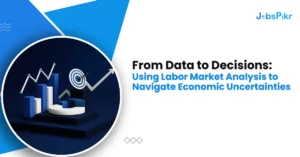Companies recognize the significance of having the ideal personnel in appropriate positions at opportune moments. Yet, attaining this objective is not consistently simple given the quick tempo of contemporary business environments. Consequently, strategic workforce planning (SWP) has become a vital field of interest for organizations aiming to remain ahead of the competition.
One tool that can significantly aid in strategic workforce planning efforts is job market analytics. Organizations can leverage data analytics to extract meaningful information about labor market tendencies and fluctuations, facilitating well-informed choices concerning hiring, training, and retention.
This piece delves into the amalgamation of job market analytics within strategic workforce planning, highlighting how data-centric understandings empower forecasting of forthcoming workforce necessities while addressing underlying challenges.
Understanding Strategic Workforce Planning
Strategic workforce planning refers to a methodical series of steps aimed at assessing an organization’s current workforce, pinpointing any shortcomings or vulnerabilities, and devising tactics to tackle these problems. Its primary aim is to ensure the enterprise has the necessary capabilities and proficiency aligned with its long-term goals. Typically, SWP comprises distinct phases: conducting workforce analysis, crafting plans, executing them, and monitoring progress.
The Role of Job Market Analytics in Strategic Workforce Planning
Job market analytics refer to the employment of data and analytical methods to comprehend labor market patterns and tendencies. These insights can prove incredibly beneficial in strategic workforce planning since they offer critical details about talent supply and costs, informing hiring, training, and retention choices. Examples of utilizing job market analytics in SWP encompass examining job posting statistics to pinpoint highly sought-after skills or scrutinizing staff attrition rates and worker satisfaction polls to determine problematic regions requiring intervention.
Leveraging Data-Driven Insights for Strategic Workforce Planning
To maximize the advantages offered by job market analytics in strategic workforce planning, incorporating data-driven insights throughout every phase of the procedure is essential. Several approaches to realizing this include:
1. Gathering Comprehensive Workforce Insights Through Internal and External Data Sources: Performing exhaustive workforce research employing both internal and external data sources. Internal resources may consist of efficiency appraisals, succession schemes, and a variety of measurements, whereas outside data may comprise sector standards, financial variables, and labor force developments.
2. Creating a Data-Driven Workforce Strategy: Formulating a workforce blueprint grounded on data-driven findings. Such actions might entail establishing specific diversity goals, devising professional growth initiatives, or adopting advanced technologies aimed at enhancing efficiency.
3. Implementing the Plan Using Evidence-Based Decision-Making: Executing the program through evidence-based decision-making procedures. Activities within this category might include deploying screening algorithms to sift through résumés and evaluate applicants or applying learning analytics to tailor educational materials and gauge efficacy during skill development ventures.
4. Monitoring Progress With Metrics and Analytics: Supervising advancement via actuality-based figures and analytics. Consistent assessment of essential performance measures—for instance, time-to-recruit, expenditure-per-recruit, and personnel commitment ratings—enables continuous improvement toward established objectives.
Forecasting Future Personnel Demands With Predictive Analytics
Predictive analytics extend data-driven understanding even further by utilizing mathematical models and machine learning techniques to project prospective results. Within strategic workforce planning, predictive analytics enable firms to foresee forthcoming staff requirements and organize them appropriately. Illustrative applications incorporate estimating imminent vacancies arising from retirements, promotions, and transfers, then preparing correspondingly; or recognizing emerging innovations in engineering and robotics and crafting retraining projects to upskill team members facing possible automation threats.
Aligned Talent Procurement With Market Patterns
A significant element of strategic workforce planning pertains to harmonizing talent procurement with prevailing market movements. Essentially, this implies drawing in leading professionals in addition to attuning attraction tactics to wider commercial and social changes. Instances of such transitions embrace presenting versatile working arrangements accommodating rising requests for equilibrium between occupation and life, or cultivating varied candidate shortlists reflecting evolving population characteristics and heightened significance placed upon inclusivity.
Surmounting Barriers in Strategic Workforce Planning Using Analytics
Despite the numerous merits associated with labor market analytics in strategic workforce planning, particular hurdles persist. Common difficulties comprise insufficient data quality, siloed datasets across functional domains, and opposition to alteration. Addressing these concerns necessitates deliberate steps, such as procuring dependable data accumulation and administration frameworks, promoting interdepartmental cooperation, and fostering awareness concerning the value added by fact-based workforce preparation together with suitable education and assistance provided to stakeholders.
Conclusion
Strategic workforce planning plays a pivotal function in optimally allocating human capital assets inside contemporary enterprises.
Integrating job market analytics offers substantial advantages for organizations aiming to predict future staff demands, streamline talent acquisition, and bolster worker development. JobsPIkr is a market leader in this domain helping several companies achieve their potential. If you would like to know how we can help your organization, sign up for a free trial today.




